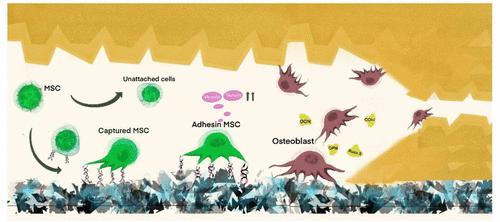当前位置:
X-MOL 学术
›
ACS Appl. Mater. Interfaces
›
论文详情
Our official English website, www.x-mol.net, welcomes your
feedback! (Note: you will need to create a separate account there.)
Aptamer/Hydroxyapatite-Functionalized Titanium Substrate Promotes Implant Osseointegration via Recruiting Mesenchymal Stem Cells
ACS Applied Materials & Interfaces ( IF 8.3 ) Pub Date : 2022-09-15 , DOI: 10.1021/acsami.2c10809
Yujia Wei 1 , Maohua Chen 1 , Menghuan Li 2 , Dong Wang 1 , Kaiyong Cai 1 , Zhong Luo 2 , Yan Hu 1
ACS Applied Materials & Interfaces ( IF 8.3 ) Pub Date : 2022-09-15 , DOI: 10.1021/acsami.2c10809
Yujia Wei 1 , Maohua Chen 1 , Menghuan Li 2 , Dong Wang 1 , Kaiyong Cai 1 , Zhong Luo 2 , Yan Hu 1
Affiliation

|
Endowing bone regeneration materials with both stem cell recruitment and osteoinduction properties is a key factor in promoting osseointegration of titanium (Ti) implants. In this study, Apt19s-grafted oxidized hyaluronic acid (OHA) was deposited onto a protein-mediated biomineralization hydroxyapatite (HAp) coating of Ti. HAp was achieved by the treatment of lysozyme and tris(2-carboxyethyl) phosphonate mixture and then soaked in calcium ion (Ca2+) solution to obtain functional Ti substrate (Ti/HAp/OHA-Apt). In vitro studies confirmed that Ti/HAp/OHA-Apt could effectively maintain the sustained release of Apt19s from Ti for 7 days. The released Apt19s significantly enhanced the migration of bone marrow mesenchymal stem cells (MSCs), which was reflected by the experiment of transwell assay, wound healing, and zymogram detection. Compared with pure Ti, Ti/HAp/OHA-Apt was able to adjust the adsorption of functional proteins at the Ti-based interface to expose their active sites, which significantly increased the expression of adhesion-associated proteins (vinculin and tensin) in MSCs to promote their adhesion on Ti-based interface. In vitro cell experiments of alkaline phosphatase activity staining, mineralization detection, and expression of osteogenesis-related genes showed that Ti/HAp/OHA-Apt significantly enhanced the osteogenic differentiation ability of MSCs, which may be highly related to the porous structure of hydroxyapatite on Ti interface. In vivo test of Micro-CT, H&E staining, and histochemical staining further confirmed that Ti/HAp/OHA-Apt was able to promote MSC recruitment at the peri-implant interface to form new bone. This work provides a new approach to develop functional Ti-based materials for bone defect repair.
中文翻译:

适体/羟基磷灰石功能化钛基质通过招募间充质干细胞促进植入物骨整合
赋予骨再生材料以干细胞募集和骨诱导特性是促进钛 (Ti) 植入物骨整合的关键因素。在这项研究中,Apt19s 接枝的氧化透明质酸 (OHA) 沉积在蛋白质介导的生物矿化羟基磷灰石 (HAp) 钛涂层上。HAp是通过溶菌酶和三(2-羧乙基)膦酸盐混合物处理,然后浸泡在钙离子(Ca 2+ )溶液中得到功能性Ti底物(Ti/HAp/OHA-Apt)。体外研究证实,Ti/HAp/OHA-Apt 可以有效维持 Apt19s 从 Ti 中持续释放 7 天。释放的 Apt19s 显着增强了骨髓间充质干细胞 (MSCs) 的迁移,这在 transwell 测定、伤口愈合和酶谱检测的实验中得到了体现。与纯 Ti 相比,Ti/HAp/OHA-Apt 能够调节功能蛋白在 Ti 基界面的吸附,从而暴露其活性位点,从而显着增加 MSCs 中粘附相关蛋白(vinculin 和 tensin)的表达以促进它们在钛基界面上的附着力。体外碱性磷酸酶活性染色、矿化检测、成骨相关基因表达的细胞实验表明,Ti/HAp/OHA-Apt显着增强了MSCs的成骨分化能力,这可能与Ti界面上羟基磷灰石的多孔结构高度相关。 . Micro-CT、H&E染色和组织化学染色的体内试验进一步证实Ti/HAp/OHA-Apt能够促进MSC在种植体周围界面募集形成新骨。这项工作为开发用于骨缺损修复的功能性钛基材料提供了一种新方法。
更新日期:2022-09-15
中文翻译:

适体/羟基磷灰石功能化钛基质通过招募间充质干细胞促进植入物骨整合
赋予骨再生材料以干细胞募集和骨诱导特性是促进钛 (Ti) 植入物骨整合的关键因素。在这项研究中,Apt19s 接枝的氧化透明质酸 (OHA) 沉积在蛋白质介导的生物矿化羟基磷灰石 (HAp) 钛涂层上。HAp是通过溶菌酶和三(2-羧乙基)膦酸盐混合物处理,然后浸泡在钙离子(Ca 2+ )溶液中得到功能性Ti底物(Ti/HAp/OHA-Apt)。体外研究证实,Ti/HAp/OHA-Apt 可以有效维持 Apt19s 从 Ti 中持续释放 7 天。释放的 Apt19s 显着增强了骨髓间充质干细胞 (MSCs) 的迁移,这在 transwell 测定、伤口愈合和酶谱检测的实验中得到了体现。与纯 Ti 相比,Ti/HAp/OHA-Apt 能够调节功能蛋白在 Ti 基界面的吸附,从而暴露其活性位点,从而显着增加 MSCs 中粘附相关蛋白(vinculin 和 tensin)的表达以促进它们在钛基界面上的附着力。体外碱性磷酸酶活性染色、矿化检测、成骨相关基因表达的细胞实验表明,Ti/HAp/OHA-Apt显着增强了MSCs的成骨分化能力,这可能与Ti界面上羟基磷灰石的多孔结构高度相关。 . Micro-CT、H&E染色和组织化学染色的体内试验进一步证实Ti/HAp/OHA-Apt能够促进MSC在种植体周围界面募集形成新骨。这项工作为开发用于骨缺损修复的功能性钛基材料提供了一种新方法。

































 京公网安备 11010802027423号
京公网安备 11010802027423号